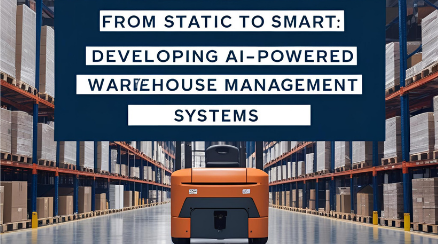From Static to Smart: Developing AI-Powered Warehouse Management Systems

Strong 8k brings an ultra-HD IPTV experience to your living room and your pocket.
Introduction
Warehouse Management Systems (WMS) have traditionally relied on manual data entry, barcode scanning, and rigid workflows. These static systems often struggle with real-time visibility, error-prone inventory tracking, and labor inefficiencies. With the integration of Artificial Intelligence (AI), modern WMS solutions are shifting toward smarter, more adaptive systems. This blog explores how AI is transforming Warehouse Management Software development and what it means for businesses aiming to optimize warehouse operations.
The Role of AI in Modern Warehousing
Why AI Matters in Warehousing
Warehouses are dynamic environments that handle large volumes of data, rapid decision-making, and frequent operational changes. AI helps manage this complexity by automating routine tasks, enhancing decision-making through data analysis, and improving resource allocation.
Key Benefits of AI in WMS
- Inventory Accuracy: AI improves inventory accuracy by detecting patterns in order fulfillment and stock movement.
- Labor Optimization: Machine learning algorithms forecast labor needs based on historical data and seasonal trends.
- Demand Forecasting: AI models analyze sales trends and external factors to predict future demand.
- Error Reduction: Vision systems and AI-based checks reduce human errors in picking and packing processes.
Core AI Technologies in Warehouse Management
1. Machine Learning (ML)
Machine learning is used for pattern recognition and predictive analysis. In a warehouse setting, ML can predict inventory shortages, maintenance needs, and order volumes.
2. Computer Vision
Computer vision supports visual recognition tasks like product identification, defect detection, and real-time inventory tracking through cameras.
3. Natural Language Processing (NLP)
NLP allows warehouse systems to understand voice commands or text-based queries, improving usability for workers and managers.
4. Robotics and AI
AI-powered robots can autonomously move goods, perform picking tasks, and support restocking. These robots adapt to warehouse layouts using reinforcement learning.
Transitioning from Traditional to AI-Driven WMS
Understanding the Gap
Legacy systems often rely on rule-based logic and require manual updates to workflows. This limits scalability and responsiveness. Transitioning to AI-powered systems involves modernizing both the software and underlying hardware infrastructure.
Steps to Implement AI in WMS
Step 1: Data Collection and Cleaning
AI systems rely on quality data. Start by centralizing data from IoT sensors, inventory databases, and historical records.
Step 2: Integrate Real-Time Analytics
Implement systems capable of processing data streams in real time to support dynamic decision-making.
Step 3: Choose the Right AI Models
Select AI models based on specific warehouse needs, such as classification models for product sorting or regression models for demand forecasting.
Step 4: Develop User Interfaces
Design user interfaces that allow workers to interact seamlessly with AI-driven recommendations and alerts.
Step 5: Monitor and Iterate
AI systems must be continuously monitored and retrained as new data is collected.
Real-World Applications of AI in WMS
Predictive Maintenance
AI models analyze sensor data from warehouse machinery to predict equipment failures before they occur. This reduces downtime and avoids costly repairs.
Intelligent Slotting
AI optimizes the placement of goods in a warehouse based on picking frequency, size, and weight. This shortens pick paths and reduces labor hours.
Autonomous Inventory Checks
Drones and robotic systems equipped with AI perform regular inventory checks without human intervention. These systems detect misplaced items and update stock records in real time.
Demand-Driven Replenishment
By analyzing sales data and market trends, AI models predict stock requirements and automate restocking decisions.
Challenges in AI Integration
Data Privacy and Security
AI systems require access to sensitive data. Ensuring data privacy through encryption and access control is critical.
Integration with Existing Systems
Legacy ERP or WMS platforms may not support AI modules out of the box. Custom integration is often required.
Talent and Training
Employees need training to work with AI-powered systems. This includes understanding AI recommendations and interacting with new tools.
Choosing the Right Development Partner
Whether you are building a new system or upgrading an existing one, the right development team is essential. A team with experience in custom logistics software development can design AI features tailored to specific warehouse operations.
Cost Considerations
Factors Affecting Cost
- Scope and complexity of features
- Number of AI models implemented
- Integration with other enterprise systems
- Hardware (IoT devices, cameras, robots)
For a breakdown of what to expect, consider reading more about logistics app development cost to understand pricing variables.
Industry Trends and AI Adoption Rates
According to recent AI development statistics, the logistics industry is among the top sectors rapidly adopting AI. With increased investments and proven ROI, warehouse operators are accelerating AI adoption.
Future Outlook
AI + IoT
Combining AI with IoT will lead to highly automated warehouses. Sensors will feed data to AI models in real time, enabling instant decision-making.
Human-AI Collaboration
AI will augment human decision-making rather than replace it. For example, AI can suggest optimal pick paths while workers perform the physical tasks.
Cloud-Based WMS with AI
Cloud platforms offer scalability and remote access. Future WMS systems will likely be cloud-native, enabling easier integration with AI services.
Conclusion
AI is not a futuristic concept for warehouse management; it's already in use across leading logistics operations. Businesses that adopt AI in warehouse management software development gain in efficiency, accuracy, and cost-effectiveness. By understanding the technologies involved and planning a step-by-step integration strategy, companies can shift from static, rule-based systems to smart, data-driven operations that respond in real time.
Whether you're optimizing an existing system or building one from scratch, AI will be a core component of the next generation of warehouse management solutions.
Note: IndiBlogHub features both user-submitted and editorial content. We do not verify third-party contributions. Read our Disclaimer and Privacy Policyfor details.







